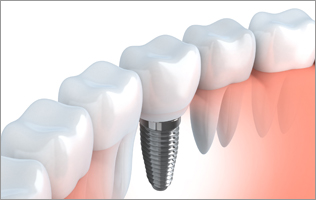Natural bone insufficiency can be caused by :
• Gum disease
• Tooth development defects
• Wearing dentures long term
• An injury to the face or trauma
• Spaces left empty in the mouth after teeth are removed
• Dental procedures where efforts were not made to restore natural bone
Several techniques are used to rebuild bone, restore your natural jaw line and smile, and provide a strong and sturdy foundation for implant-supported teeth. Most patients proceed with everyday life and work often by the next day and continue throughout the months in between dentist appointments.

Below is an overview of some of the more common techniques to augment bone :
Bone Grafts
Bone grafting is a safe and highly successful procedure that involves the “building up” or adding bone to the jaw by using your own natural bone from another location and/or by using donor, processed or synthetic bone materials. Often the new bone can be obtained from inside the mouth. Ask your dental implant dentist about the advantages of different bone grafting methods and materials so that, together, you can make an informed decision.
After the procedure, you will usually be given antibiotics, pain medication if needed, and an antibacterial mouthwash, and instructed to avoid eating certain foods and putting pressure on the bone graft. You will return home in between dentist appointments while the bone graft heals and should be able to work and go about your everyday life.
Your implants will be placed after the grafted bone has fused or become a strong, integrated part of the existing bone. The amount of time the integration takes varies depending on the location of the graft and the density of the bone. It may take three or more months.
Sinus Lift
(Sinus Augmentation or Sinus Elevation).A sinus lift is surgery that adds bone to your upper jaw in the area of your molars and premolars. It’s sometimes called a sinus augmentation. The bone is added between your jaw and the maxillary sinuses, which are on either side of your nose. To make room for the bone, the sinus membrane has to be moved upward, or “lifted.” A sinus lift usually is done by a specialist. This could be either an oral and maxillofacial surgeon. A sinus lift, also called sinus augmentation or sinus elevation, is a bone-augmentation procedure for patients who have insufficient natural bone in this area for dental implant placement. The procedure involves adding bone below the sinus so that one or more implants can be placed. The procedure does not affect speech, intonation or cause sinus problems.
After the bone has been given time to develop, usually for approximately four to 12 months, dental implants can be placed. Sinus augmentation, which many patients say causes only minimal discomfort, is designed to help ensure that your implants are long-lasting, with ample, strong and sturdy bone that will allow your new teeth to fit and function like healthy, natural teeth.






